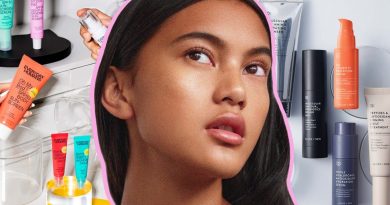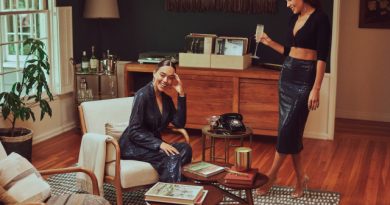Women’s Sneaker Culture Explored in New Book – WWD
Ivy Park founder Beyoncé, Sacai designer Chitose Abe, Ambush designer Yoon Ahn, Foot Locker women’s creative director Melody Ehsani, Puma women’s basketball creative director June Ambrose, tennis legend Serena Williams — all have played a role in increasing visibility for women in the sneaker industry.
Arriving just in time for holiday gifting, “She Kicks,” $95, shines a light on these women and more, featuring the trailblazing designers, executives, athletes, entrepreneurs and influencers who are changing the game.
Written by Nav Gill, former editor of Hypebae, and Sanne Poeze, the Dutch inflluencer and sneaker collector, the book was published by indie New York house Studio 96, and incorporates technology that can be scanned using an app to expand content, access giveaways and shop styles.
“There’s such a rich history, so many great images and great stories, but there was no one place where all of that existed,” said Gill via a video interview from her home in London. “So I guess in a very selfish way we wanted to create a book that we wanted to read.”
The coffee-table tome has lots of photos and short sections on design and silhouette, collaborations, milestone moments, female-owned stores and stepping into the future with sustainability and Web3, among other subjects.
Brands only really began to cater to women’s performance sneakers after the enactment of Title IX in 1972, which ensured equal access to sports in public schools. The book features ads for the Lady Waffle, which Nike introduced in 1977, and for the Lady Vans product line introduced in 1984.
“The 1990s is really where sneaker design was becoming more of a viable career path for women because the industry was booming,” said Gill, highlighting designer Stephanie Howard, who studied industrial design in college and joined New Balance as a designer in 1994, where one of her earliest projects was the NB 850.
Howard went on to roles at Nike and Reebok, before cofounding NFT-meets-physical sneaker brand Endstate. “You see now when you go into design rooms, it still skews very heavily toward one gender, but there are more women undeniably than there were when Stephanie Howard started out,” said Gill.
Sneaker fashion collaborations continue to be an engine of growth and from the authors’ perspective, some of the most notable have been engineered by women. Chitose Abe is one.
“What personally I found really interesting about her collaborations in particular was just how coveted they were across the sphere, by people of all genders. It wasn’t, we’re working with a female designer, and here’s like a small side run of women’s exclusives. The LDV Waffle was the Complex shoe of the year in 2018. They were hyped by everyone and they’re still very hard to get ahold of,” said Gill.
The book shares the story of how Abe got to that specific design with the layering and doubling down of a sole, which mirrors the hybridization technique that’s at the core of her fashion brand. “It’s such a great example of when collaborations really work and they’re not done for collaboration’s sake,” said Gill.
In the streetwear space, designer Melody Ehsani was groundbreaking for creating a physical hub for female sneaker culture with her brand store on Fairfax Avenue in L.A. — a street that otherwise has been very male-dominated with stores like Supreme, Huf, Diamond Supply Co. and The Hundreds.
Ehsani designed early collaborations with Reebok, but her shoes for Nike Jordan have been the most hyped, namely her AJ 1 Fearless shoes, with rainbow colorblocking, watch face embellishment and handwritten messages.
“She’d had all these design meetings in Portland trying to bring the shoe to life and nothing was clicking for the execs,” Gill recalled. “They told her if you don’t have something that works by end of the day, we’re calling it. And she created the shoe that we’ve all seen and love in eight hours. Ultimately when you look at that shoe, it’s a really personal expression of Melody’s identity and you have the handwriting spelling out the mantra, ‘if you knew what you had was rare, you wouldn’t waste it.’”
Other sneaker design creatives, including Aleali May and June Ambrose, came through the styling space.
May grew up as a fan of Jordans and was inspired by Maya Moore, the WNBA basketball player who became the first female athlete to ink a deal with the brand. Together they designed the AJ1 Court Lux in 2018.
Ambrose, who has worked with Alicia Keys, Mary J. Blige and Jay Z, made history joining Puma as creative director in 2020.
“There’s definitely a lot of women in great positions throughout the industry, but creative director is a title historically even at fashion houses that is a man. When these appointments happen — and they don’t happen enough — it creates visibility. Because you can’t be what you can’t see,” said Gill.
Another force driving female sneaker culture forward has been female athletes themselves. It wasn’t until 1995 that basketball player Sheryl Swoopes became the first female athlete to have a signature athletic shoe, signing with Nike. “In 1999 was the first women’s pro skate shoe, which was with Vans and Cara-Beth Burnside, so there were some great moments in the ’90s but it was very slow to grow after that,” said Gill.
“We’re just now finally seeing women’s specific soccer cleats, which is insane because the National Women’s Soccer League is huge, the Women’s Super League here in England is huge,” she continued. “I was talking to one of the designers who works at Ivy Park, she’d seen firsthand female athletes having to tape up their feet and stuff paper into male silhouettes to make them work….I can only hope with the success of the WNBA and sport becoming more of an actual equal-ish playing ground that brands will be forced to produce footwear that works for the female athlete.”
Celebrity is the last and maybe the largest pillar of industry influence, despite the pitfalls that can come with it, as seen recently over Kanye West being dropped by Adidas.
“People are always going to be inspired by celebrities, and they have such massive selling potential. The examples of Kanye, Beyoncé’s Ivy Park and Rihanna’s Fenty, when those partnerships were biggest was when they were at the pinnacles of their careers and could sell anything. But it depends on the celebrity and the cosign. Sneaker consumers can see through the BS, and it has to be something meaningful.”
What’s more interesting to Gill is the next gen of budding creatives collaborating with sneaker brands, such as Joe Freshgoods, the artist and creative director from Chicago whose “Performance Art” collection with New Balance has been a hit.
“He wasn’t huge, but this collaboration has really elevated his career,” she said. “We’ve seen the same with Helen Kirkum, who was a designer at Adidas and has branched out into her own thing, as an independent designer focusing on sustainability,” Gill said of the British designer making bespoke sneakers collaged from waste.
“Yes, celebrities will always play a part in the industry, but what I love about sneaker culture is how it democratized creativity and design. People love a good shoe and often it doesn’t matter who’s designed it. And that can propel the careers of emerging creators as well.”




